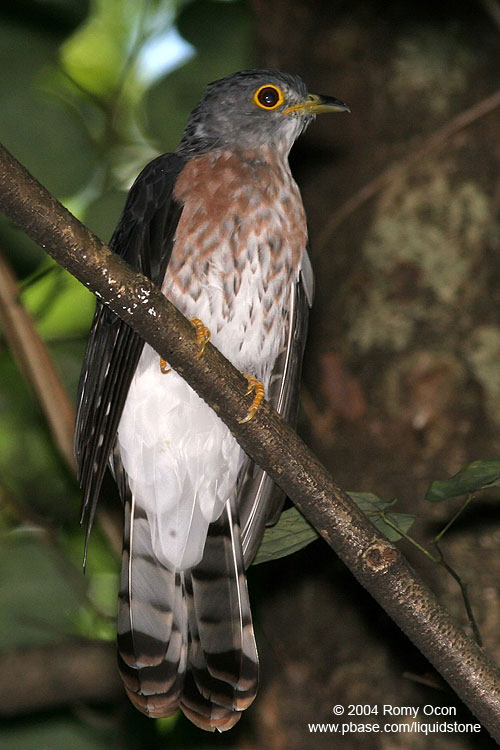(→Taxonomy: Update link) |
Aloktewari (talk | contribs) (OBI link deleted) |
||
| Line 35: | Line 35: | ||
==External Links== | ==External Links== | ||
{{GSearch|Hierococcyx+pectoralis}} | {{GSearch|Hierococcyx+pectoralis}} | ||
| − | + | ||
[[Category:Birds]] [[Category:Hierococcyx]] | [[Category:Birds]] [[Category:Hierococcyx]] | ||
Latest revision as of 15:06, 6 May 2020
- Hierococcyx pectoralis
Cuculus pectoralis
Identification
28cm.
- Slate-grey above, wings barred grey-brown
- White loral streak
- Grey and black banded tail with broad subterminal black band and rufous tip
- Grey chin
- White throat
- Bright rufous breast, sometimes with fine grey streaks)
- White belly and undertail-coverts
- Yellow eye-ring
Sexes similar. Juveniles have a blackish head with buff feather edges, a white nape, a streaked chin and a rufous wash on chest.
Distribution
Endemic to the Philippines (Palawan, Luzon, Mindoro, Sibuyan, Cebu, Negros, Leyte and Mindanao).
Uncommon to rare in its rapidly disappearing habitat.
Taxonomy
This is a monotypic species.
It was formerly considered conspecific with Malaysian Hawk-Cuckoo, Hodgson's Hawk-Cuckoo and Northern Hawk-Cuckoo.
Some authorities view Philippine Hawk-Cuckoo as belonging to genus Cuculus.
Habitat
Virgin mossy to dipterocarp forest. Occurs up to 2400m.
Behaviour
Diet
Feeds on insects, mainly caterpillars. Takes also berries.
Breeding
Very little known. A brood parasitic.
Movements
A resident species.
References
- Clements, J. F., T. S. Schulenberg, M. J. Iliff, B.L. Sullivan, C. L. Wood, and D. Roberson. 2012. The eBird/Clements Checklist of Birds of the World. 6th ed., with updates to October 2012. Ithaca: Cornell Univ. Press. ISBN 978-0801445019. Spreadsheet available at http://www.birds.cornell.edu/clementschecklist/downloadable-clements-checklist
- Del Hoyo, J, A Elliot, and J Sargatal, eds. 1997. Handbook of the Birds of the World. Volume 4: Sandgrouse to Cuckoos. Barcelona: Lynx Edicions. ISBN 978-8487334221
Recommended Citation
- BirdForum Opus contributors. (2024) Philippine Hawk-Cuckoo. In: BirdForum, the forum for wild birds and birding. Retrieved 1 May 2024 from https://www.birdforum.net/opus/Philippine_Hawk-Cuckoo




